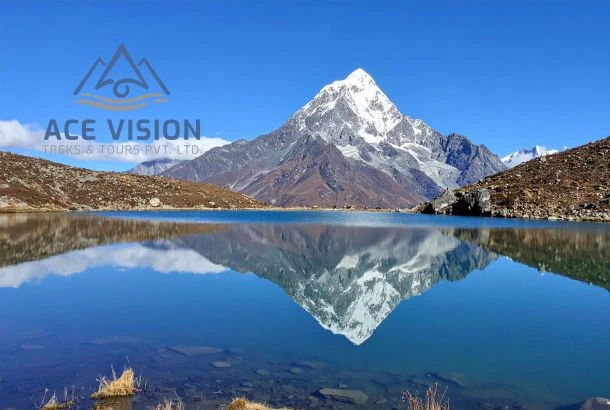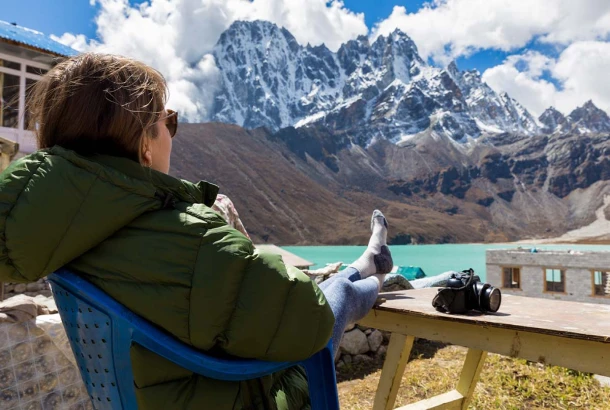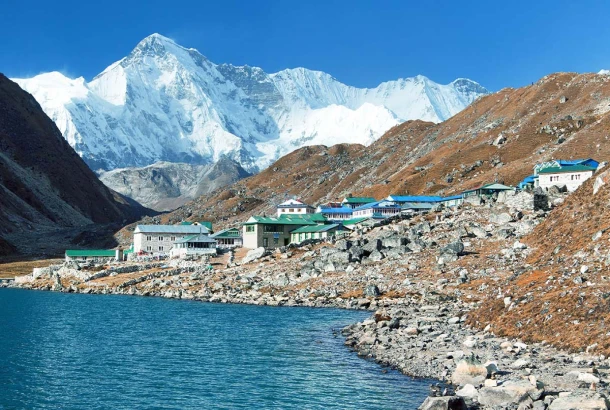Major Challenges of Gokyo Lake Trekking Difficulty
Physically Challenging Part
Overall Duration of Trekking
This exciting journey in the eastern Himalayan region takes two weeks. Besides trekking on the mainstream Everest Base Camp Trek, journey explores the remote sections of the Gokyo Valley. Gokyo Lake Trekking difficulty is moderate level, you will have to put in a lot of physical effort during the trekking part. During the trekking days, you will have to navigate your way across demanding parts of the trails for multiple hours. So, for trekkers who are not used to high-altitude journeys and have not made an adequate level of physical preparation, overall Everest trek is an exhausting experience.
Varied Terrains
The multiple hours of trekking during each exploration is a challenging endeavor due to the diverse landscape you will have to overcome during the trek. For instance, your Gokyo Lake Trek map moves across the forested trails, alpine meadows, river crossings, several steep sections, and the ice and rock moraines of the Ngozumpa Glacier. So, more than the total walking hours per day, what kind of terrains you have to trek across is the main issue here. These sections are known for the loose soil, rocky, boulder-strewn, and ice and rocky surfaces, so an unprepared trekker will find it harder to move comfortably on such diverse terrain.

Altitude Gain
High Altitude in Nature
This thrilling freshwater lake system exploration is one of the highest-altitude explorations in the Nepali Himalayas. The trekking adventures in the Everest region are generally known for their high-altitude nature, and this remarkable experience in this mainstream destination lives up to its reputation. In this exciting route, you will begin your trek from Lukla (2,800 meters) after taking a flight from Kathmandu. Then, you will continue trekking on the inclining route, trekking past the major settlements in the region to reach Gokyo Lake, which is situated at an altitude of 4,790 meters (15,715 feet). However, the highest point in this trek will be the Gokyo Ri (5,357 meters), which will be your hiking destination on Day 8 of the Gokyo Lake Trek itinerary.
Thus, the altitude gain in this overall trek sums up to be around 2,557 meters (8.389 feet) from the trek starting point. That’s why high-altitude nature is one of the major hurdles in difficulty of Gokyo Lake Trekking.
Altitude Sickness
With the gain in significant altitudes, the risk of altitude sickness significantly increases. Gokyo trekking adventure doesn’t take you over the alpine slopes, and you won’t have to deal with major altitude sickness-related conditions, the risk of Acute Mountain Sickness itself is quite bothersome. The general symptoms of altitude sickness are headache, nausea, loss of appetite, fatigue, insomnia, dizziness, etc. Although they are not life-threatening, they can significantly affect the overall experience of the trek. That’s why altitude sickness is considered a major challenge of the Gokyo Lake Trekking difficulty if the trekkers don’t stick to a thorough acclimatization process.

Weather Challenges
Unpredictability
If you have done any high-altitude exploration before, then you may have understood that in higher regions, Himalayan climatic conditions are unpredictable. Similarly, in alpine regions such as the Himalayas, the region has different weather conditions of its own. Sometimes, a pleasant day can be filled with bizarre snow or rain clouds, and high storms don’t follow any specific patterns. The general weather conditions are pretty stable during the peak season, such as spring and autumn. However, if you are planning to do this trek in off-seasons like monsoon and winter, the weather phenomenon can be an underlying challenge of Everest Gokyo Lake Trekking difficulty.
Climate Variations
Nepal is a diverse country not just culturally but geographically as well. There are a total of six climatic zones in this Himalayan country that stretch from the tropical zone (below 1,000 meters) to all the way to the tundra/trans-Himalayan zone (over 5,000 meters). You begin trekking from Lukla, which is the temperate zone (below 3,000 meters), and push above the tundra zone (above 5,000 meters) in Gokyo Ri. So, due to a vast difference in climatic conditions, you have to make the preparation relevant to different altitudes, which can be a bit difficult if you have no idea how to adapt to different types of climatic zones.

Gokyo Lake Trekking Difficulty Logistic Challenges
Remoteness of Region
Gokyo Trek is an iconic and mainstream trekking trail in Nepal. Natural lover travelers understand that the mountain region is an isolated part of the country. Even if in lower regions there are good levels of services at major Sherpa towns Lukla and Namche Bazaar, in higher regions, both infrastructural and technological advancement are lagging quite behind compared to other parts of the country. So, if you are not that good at dabbling between remote and urban explorations, then this aspect can be quite a bit of a hurdle for Gokyo Lake Trekking difficulty. Due to the limited resources in different trekking regions, you may often have to compromise on the comfort and quality of available services.
Accommodation and Food
What is the mainstream part? gokyo region is an isolated mainstream trekking destination, limited options for food and accommodation facilities. The standard trekking package gets you a teahouse accommodation. If you want a little more comfortable experience, then there are Luxury accommodation options! which are premium one out of two. However, don’t expect to compare the facilities with a hotel at an urban destination, Local houses modified into local teahouses have limited resources to provide travelers with better services. The major towns have better services similar to any standard urban city, there are restaurants, cafes, bakeries, and even pubs in towns such as Namche. As for the higher regions, the available menus are quite general and standard.
Most teahouse menu is covered with traditional and cultural dishes that are mostly prepared with home-grown ingredients. Besides those, Indian dishes, Tibetan dishes, and continental menus will be nostalgic to the home. Don’t worry; vegan and vegetarian options are available at teahouses.
Arranging Permits and Regulations
One of the hassles for the new trekkers in Nepal required trekking permits and following the strict regulations while doing the trekking. There are several protected and conserved in the Himalayan region that require permits to trek, and memorizing all the regulations in a single go can be a bit of a challenge. That’s why it is much better to trek through an agency that will oversee almost every aspect of your trekking adventure. You have to collect the following permits for this thrilling freshwater lake exploration.
Gokyo Lake Trek Permits
Sagarmatha National Park Permit– US$ 30 per person
Khumbu Rural Municipality Areaa Permit– US$ 20 per person
You can apply for the national park trekking permit at tourism board office located in Kathmandu or you obtain it at Monjo, at the counter of the national park. A restricted area permit for Khumbu Rural Municipality can be obtained only in Lukla or Monjo and not in Kathmandu.

Health and Safety
Medical Facilities
We discussed the Himalayan region has limited resources, and one of the most lacking services in the region is the medical facilities. Due to the remoteness of the region, there are only a limited number of health facilities along trekking trails. You can assume this aspect as one of the health-related challenges of the Gokyo Lake Trekking difficulty. There are only a few medical facilities along the way, and they are at a great distance from each other. So, in case you do happen to get sick, you will have a long way to travel to get the necessary medical help. As you will be already exploring a high-altitude region with cold climatic conditions, there are several risks of general health issues, and if you don’t take proper care of your well-being, hygiene, and sanitization, your overall journey can be a sour experience.
Emergency Evacuation Procedure
The Himalayan region is one of the most remote parts of the country, and it is also quite behind when it comes to the mode of transport. Flights operated in the Lukla to Kathmandu route are the most viable option for a comfortable transport mode to the Everest region. Thus, if you happen to get sick or injured during the trek and need an emergency evacuation service, then you can only rely on aerial rescue operations. During emergencies, it can take a lot of time to take an airplane flight back to Kathmandu; thus, helicopter rescue is the most suitable option. The chopper lands in any part of the trail and lands at major hospitals in the city areas within a short period.

Gokyo Lake Trekking Difficulty Levels
Although there seem to be quite a few factors of the Gokyo Lake Trekking difficulty that you have to overcome during your HImalayan exploration, with a good amount of preparation, they won’t be that much of a problem.
Enough Physical Preparation
Doing an adequate level of physical preparation will help you overcome the majority of aspects of the Gokyo Lake Trekking difficulty. If you have trained enough, you find it much easier to traverse across the elevation and diverse terrains that slowly stretch to higher altitudes. A good level of training will also boost the immune system and make the acclimatization process much easier. Thus, if you are doing high-altitude treks such as this, you should never skip the physical training for the trip, as it determines your overall experience. You don’t have to aspire to be in top shape, as a general level of fitness with good health is considered sufficient for this trek.
You are generally recommended to trek for about 3 to 8 weeks for the trek depending on your physical capabilities. If you follow any kind of workout plan, that means you are already reasonably fit and don’t have to put much effort during the preparation part. As for the people who are not physically that active, they should consider the suitable and efficient training program and stay consistent with it. The high-altitude trail of this freshwater lake exploration tests your strength and endurance level to a great extent, so you need to emphasise these aspects for the preparations. Similarly, stamina and cardiovascular exercises are also very significant as the long hours of walking and letting the body adapt to new altitudes are much easier.
Trek During Peak Season
Compared to the off-trekking periods, such as monsoon (June to August) and winter (December to February), trekking in the peak seasons, such as spring (March to May) and autumn (September to November), is more comfortable. The off-seasons do present season-specific challenges during the exploration, which can elevate the grade of overall Gokyo Lake Trekking difficulty. The monsoon season is considered one of the most challenging periods for trekking in Nepal due to the bad climatic conditions. During this season, the continuous rainfall makes the trail dangerous and slippery.
Similarly, the risk of disasters like flooding, soil erosion, and landslides puts everyone on high alert and affects the trekking itinerary plan. Winter, on the other hand, is the coldest period on the mountain and thick snow on the trail and blocks at the higher regions is not that easy to overcome.
That’s why if you want to secure a comfortable and pleasant experience, you should consider doing a Gokyo trek in one of the peak seasons. The spring season has a stunning landscape covered by greenery and colorful flowers. Spring season makes a Himalayan trek a truly astonishing and magical experience. Autumn, which boasts the landscape of the fall season, is primarily known for its stability in the weather and comfortable trails. Crisp mountain views, cool temperatures, clear days, spectacular fall scenery, festive atmosphere, etc, are other highlights of doing the trek in this season.

Acclimatize Properly
As altitude sickness is one of the most concerning and bothersome factors of Gokyo Lake Trekking difficulty, you have to follow the acclimatization process thoroughly to avoid any kind of hassles. For that, if you are not that experienced that much in high-altitude treks, you should consider the packages with enough acclimatization period and slow-paced exploration. If the overall itinerary plans are fast-paced, transitioning to higher altitudes without enough rest periods can trigger the symptoms of altitude sickness. Generally, for a high-altitude trek, a person is not recommended to climb more than 500 meters (1,640 feet) within a single, and trekkers should take a sufficient acclimatization period after crossing more than 1,000 meters (3,280 feet) in the route.
Ace Vision Trek’s 13 Days Everest Gokyo Valley Trek is such a package that you don’t have to worry about not getting enough acclimatization period. Our package is designed with the help of trek and travel experts and gradually ascends the route without putting our guests at risk of altitude sickness. You will also get two acclimatization days along the route, and you will also be able to enjoy enough resting periods at the transitioning point. As this exciting adventure is slow-paced, you will also be able to take a lot of short breaks in the route and take your time with exploration.
Stay Hydrated and Eat Balanced Meals
If you take proper care of your diet and stay hydrated throughout the trekking journey, not only will you be able to keep the risk of altitude sickness at bay, but it keep your energy at an optimum level and aid your immune system. During the long hours of trekking on the physically demanding trail, a trekker will lose a significant water level from the body. So, if a trekker doesn’t fulfill the recommended level of hydration quote (which is 3 to 4 liters per day), then he/she will be at risk of altitude sickness and find it much more difficult to move around due to reduced water level in the body.
Similarly, the multiple hours of walking during each day burns a major level of energy in the body. Thus, unless a balanced diet isn’t followed to fuel the body in order to meet the physical demands of the trail, it weakens the immune system, putting the trekkers at risk of different sicknesses, which is bothersome during remote high-altitude explorations. On top of that, a weakened immune system means it is more prone to the risks of altitude sickness.
Join Guided Trekking
One of the best ways to bypass the major component of Gokyo Lake Trekking difficulty and enjoy a relaxed adventure is to join a guided trek. If you do guided trekking adventures with registered companies like Ace Vision Treks, you won’t have to worry about anything during the trek. Tour trekking agencies will take care of all the travel details and logistics details, so you don’t have to worry about food, accommodation, and transportation during the trip. Similarly, each of the trekking parties is accompanied by an experienced guide and capable crew who are trained in high altitude and first-aid care. The guides will also take care of your health and check your condition during each day of the trek.
As for the emergency rescue, although it will be covered by your insurance, guides will coordinate with the teams for a seamless operation. Similarly, the porters will also help you with your luggage, and you will be able to move around much more freely. Thus, to enjoy a remarkable and memorable experience without having to worry about any aspect of the trek, you should definitely go for guided trekking adventures.

Gokyo Trek Distance
The total Gokyo Trek distance is approximately 101 km (62.7 miles), including the start and return trip from Lukla. So, in comparison to the Everest Base Camp Trek distance, which is a total of 130 km (80 miles), the Gokyo Lake Trek is a shorter Himalayan exploration. However, depending on the high explorations and the side detours around other major highlights of the region, the Gokyo Trek distance can be even longer. Generally, the Gokyo Lake Trek lasts 13 to 17 days, deepening the itinerary plans of the trek package. You will spend around 10 days on the mountain during this freshwater lake system exploration and the rest of the days in Kathmandu. Overall Gokyo Trek distance at a slow pace, you have to hike around 5 to 6 hours on the mountain trails per day.

Gokyo Trekking Difficulty FAQs and Answer
How hard is the Gokyo Lake trek?
The Gokyo Valley trek is a moderate to adventure journey depends which season you choose during the Autumn and Spring seasons Moderate levels but in Winter and Summer an adventure journey.
How long does it take to climb Gokyo Ri?
From Gokyo Village to Day hike to Gokyo ri takes 3/4 hours but from Lukla, it takes 7 days to reach Gokyo ri.
How high/elevation is the Gokyo Lake trek?
Gokyo Valley trekking's highest elevation is 5,357m/17,570 ft.
How to reach Gokyo Lake?
Everest Gokyo Valley trek route: Arrival in Kathmandu, Phakding, Namche Bazar, Dhole, Machhermo, Gokyo Valley, and via back to Lukla and fly to Kathmandu.
Finally
Adventure outdoor activities to Gokyo Valley trekking is a lifetime travel experience for travelers. Experience, helpful, and logistics guide led your adventure to the Himalayas. Have a question about a customized trip to Nepal? Contact Ace Vision Treks's experts to minimize your risk factors before doing any Nepal trekking.
Recommended Top Travel Tips for Nepal Trekking













